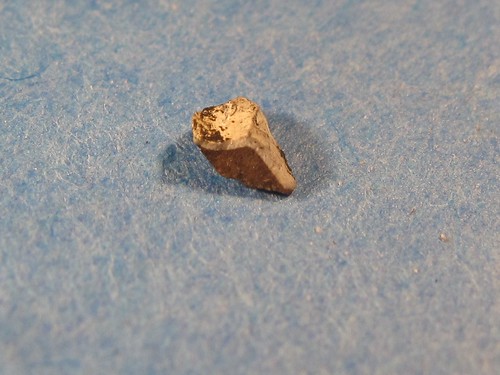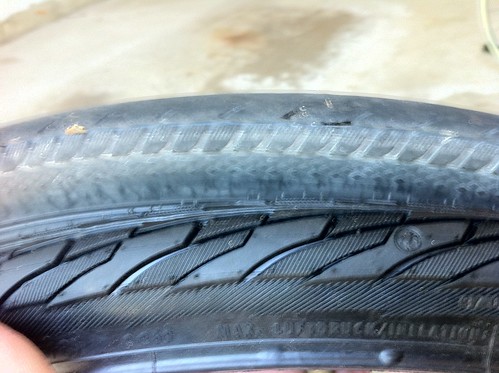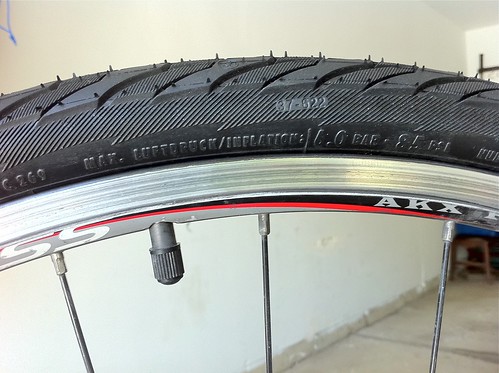Bike tire replacement
July 6, 2011 at 8:45 AM by Dr. Drang
I replaced my tires on the morning of the Fourth. The old ones had about 3600 miles on them, 2800 from last year and 800 so far this year. This is down from the 4000 miles I put on the previous set, but I had kept those on until the cords were showing, something I really didn’t want to do again.
Frankly, I probably kept this set on too long, too. I was getting flats from stupid things like this little brick chip that would never make it through a decent tread.
The new tires are Continental Contacts, my third set. Although the name and model number are the same, Continental has changed the tread design. I doubt the change will affect the tire life significantly, but that’s why I put the mileage figures up in the first paragraph; if this set doesn’t last like the others, I’ll have to move on to another model.
If you are, like me, the maintainer of various family bicycles—with different tires and different recommended inflation pressures—you probably can’t remember which pressure to use with which tire. The pressure is written on the tire, of course, but its not always easy to find that spot on the tire. Black lettering on a black tire doesn’t exactly jump out at you.
Here’s how I always know where to look: When I put the inner tube in the tire, I position it so the valve is near the pressure marking. This one shifted on me as I put the tire on the rim—I started out with the “85 psi” right in line with the valve stem—but it’s still close enough that I won’t have to hunt around to find the marking.
A simple trick, but it saves time and frustration.
This tip presupposes that you fix your own tires, something you really should do. I was in a bike store a couple of weeks ago, and as I was checking out, a man came in with two little bikes. The bikes were the size a five-year-old would ride—probably had their training wheels taken off this spring. They both had flat tires, and he was bringing them in to have them fixed.
Bringing in small children’s bikes. To have their flat tires fixed. By a mechanic.
Now, I know that the town I live in is filled with salesmen, the type of men who, as my father used to say, couldn’t find their ass with both hands. And I know that everyone has different talents and that I should be more tolerant of the non-mechanically inclined. Furthermore, I like to think I’m generally enlightened in my view of gender roles. But I can’t help thinking there’s something terribly unmanly about an adult male carrying two kiddie bikes into a shop because he’s unable to change an inner tube. I can’t imagine a single male relative of mine who would have done such a thing. It’s as if the guy walked into the store and announced “Can you help me? I have no penis.”
This is unfair of me, I know. I wouldn’t think badly of a woman who came in to have flat tires fixed. But no one said life is fair. So if you don’t want me snickering at you in a bike shop, learn to fix a flat. Changing an inner tube is easy, as is using a patch kit.1 It’s much faster to do it yourself than to haul your bike off to a shop, and it gives you more time for riding.
-
Often, the trickiest thing in patching a tire is finding the damned hole in the tube. Many’s the time I’ve had to submerge a tube in a bucket of water and look for bubbles because the leak was so slow I couldn’t hear the air whistling out. ↩




